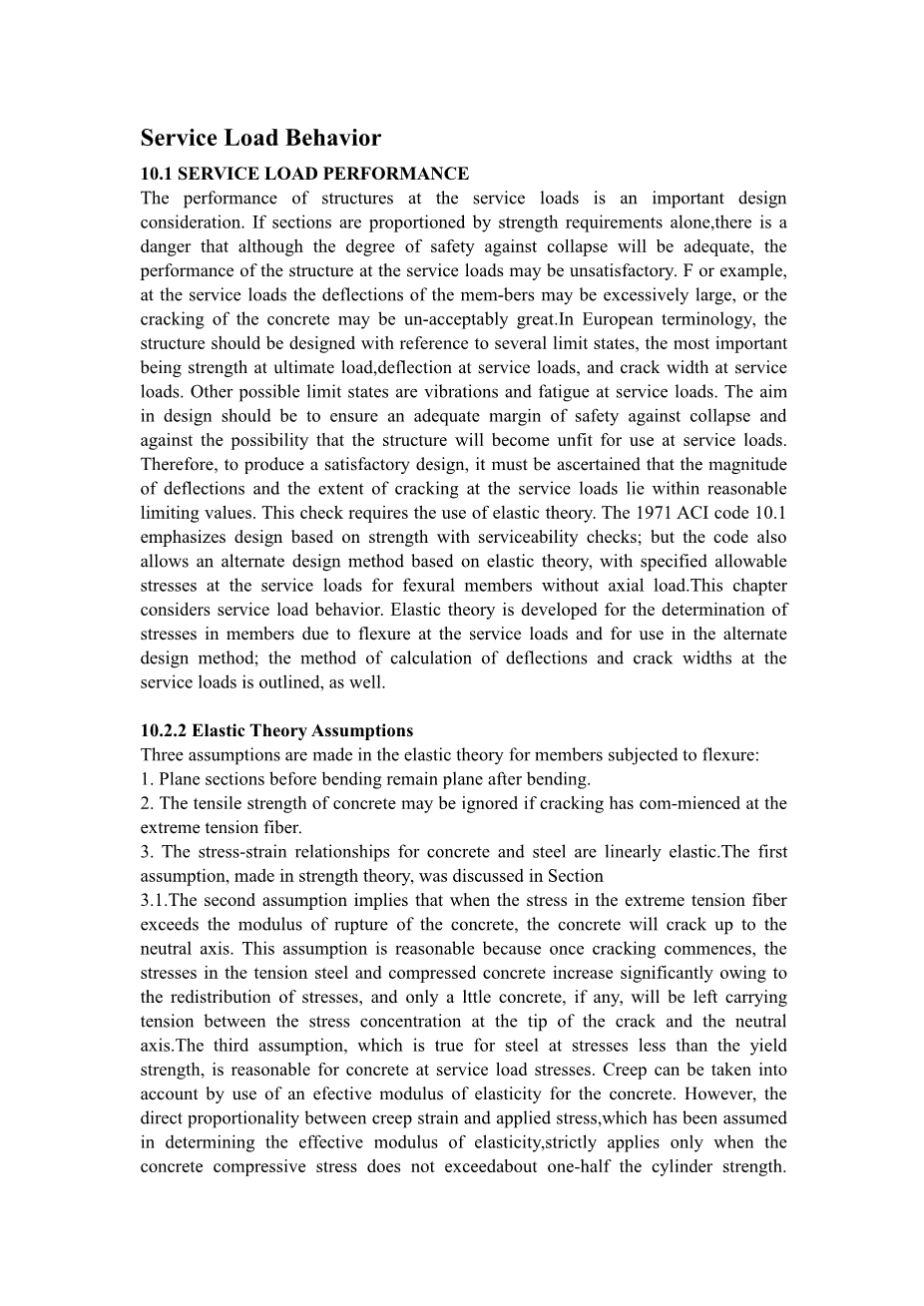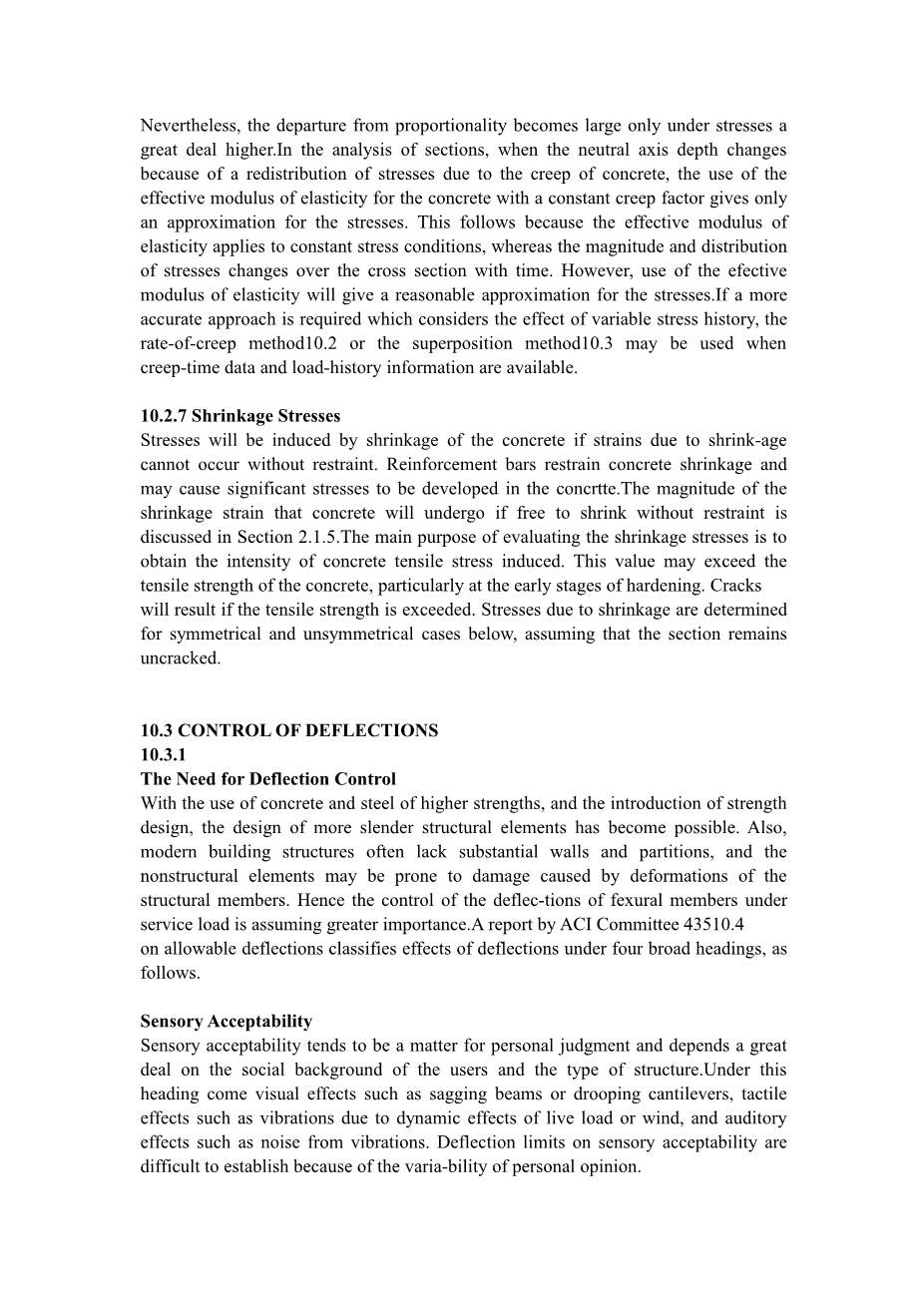

英语原文共 11 页,剩余内容已隐藏,支付完成后下载完整资料
B.1 英文原文
Service Load Behavior
10.1 SERVICE LOAD PERFORMANCE
The performance of structures at the service loads is an important design consideration. If sections are proportioned by strength requirements alone,there is a danger that although the degree of safety against collapse will be adequate, the performance of the structure at the service loads may be unsatisfactory. F or example, at the service loads the deflections of the mem-bers may be excessively large, or the cracking of the concrete may be un-acceptably great.In European terminology, the structure should be designed with reference to several limit states, the most important being strength at ultimate load,deflection at service loads, and crack width at service loads. Other possible limit states are vibrations and fatigue at service loads. The aim in design should be to ensure an adequate margin of safety against collapse and against the possibility that the structure will become unfit for use at service loads. Therefore, to produce a satisfactory design, it must be ascertained that the magnitude of deflections and the extent of cracking at the service loads lie within reasonable limiting values. This check requires the use of elastic theory. The 1971 ACI code 10.1 emphasizes design based on strength with serviceability checks; but the code also allows an alternate design method based on elastic theory, with specified allowable stresses at the service loads for fexural members without axial load.This chapter considers service load behavior. Elastic theory is developed for the determination of stresses in members due to flexure at the service loads and for use in the alternate design method; the method of calculation of deflections and crack widths at the service loads is outlined, as well.
10.2.2 Elastic Theory Assumptions
Three assumptions are made in the elastic theory for members subjected to flexure:
1. Plane sections before bending remain plane after bending.
2. The tensile strength of concrete may be ignored if cracking has com-mienced at the extreme tension fiber.
3. The stress-strain relationships for concrete and steel are linearly elastic.The first assumption, made in strength theory, was discussed in Section
3.1.The second assumption implies that when the stress in the extreme tension fiber exceeds the modulus of rupture of the concrete, the concrete will crack up to the neutral axis. This assumption is reasonable because once cracking commences, the stresses in the tension steel and compressed concrete increase significantly owing to the redistribution of stresses, and only a lttle concrete, if any, will be left carrying tension between the stress concentration at the tip of the crack and the neutral axis.The third assumption, which is true for steel at stresses less than the yield strength, is reasonable for concrete at service load stresses. Creep can be taken into account by use of an efective modulus of elasticity for the concrete. However, the direct proportionality between creep strain and applied stress,which has been assumed in determining the effective modulus of elasticity,strictly applies only when the concrete compressive stress does not exceedabout one-half the cylinder strength. Nevertheless, the departure from proportionality becomes large only under stresses a great deal higher.In the analysis of sections, when the neutral axis depth changes because of a redistribution of stresses due to the creep of concrete, the use of the effective modulus of elasticity for the concrete with a constant creep factor gives only an approximation for the stresses. This follows because the effective modulus of elasticity applies to constant stress conditions, whereas the magnitude and distribution of stresses changes over the cross section with time. However, use of the efective modulus of elasticity will give a reasonable approximation for the stresses.If a more accurate approach is required which considers the effect of variable stress history, the rate-of-creep method10.2 or the superposition method10.3 may be used when creep-time data and load-history information are available.
10.2.7 Shrinkage Stresses
Stresses will be induced by shrinkage of the concrete if strains due to shrink-age cannot occur without restraint. Reinforcement bars restrain concrete shrinkage and may cause significant stresses to be developed in the concrtte.The magnitude of the shrinkage strain that concrete will undergo if free to shrink without restraint is discussed in Section 2.1.5.The main purpose of evaluating the shrinkage stresses is to obtain the intensity of concrete tensile stress induced. This value may exceed the tensile strength of the concrete, particularly at the early stages of hardening. Cracks
will result if the tensile strength is exceeded. Stresses due to shrinkage are determined for symmetrical and unsymmetrical cases below, assuming that the section remains uncracked.
10.3 CONTROL OF DEFLECTIONS
10.3.1
The Need for Deflection Control
With the use of concrete and steel of higher strengths, and the introduction of strength design, the design of more slender structural elements has become possible. Also, modern building structures often lack substantial walls and partitions, and the nonstructural elements may be prone to damage caused by deformations of the structural members. Hence the control of the deflec-tions of fexural members under service load is assuming greater importance.A report by ACI Committee 43510.4
on allowable deflections classifies effects of deflections under four broad headings, as follows.
Sensory Acceptability
Sensory acceptability tends to be a matter for personal ju
剩余内容已隐藏,支付完成后下载完整资料
资料编号:[415905],资料为PDF文档或Word文档,PDF文档可免费转换为Word


